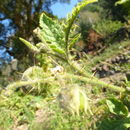en
names in breadcrumbs


Solanum sisymbriifolium is commonly known as vila-vila,[1] sticky nightshade,[2] red buffalo-bur,[3] the fire-and-ice plant, litchi tomato, or Morelle de Balbis.[4]
The small edible fruits are red[5] on the outside and yellow inside. It grows inside a spiny, green husk. The fruit is ripe when it is easily removed from the stem. The flavor resembles sour cherries and a little bit like a tomato.[4]
This plant has been used as a trap crop to protect potatoes from potato cyst nematode.[6] The stems and leaves contain solasodine which makes the plant very resistant to many pests and diseases, with the exception of potato beetles and tomato hornworms. It can also be used as a hedge plant to keep animals out of a garden, because it is covered with prickles (erroneously called thorns).[4]
The sticky nightshade has been described under a number of illegitimate scientific names, many of them quite ambiguous homonyms:[7]
Several forms and varieties have been named,[7] but these are generally not considered distinct today:
In South Africa it is listed as a Category 1b invader in the National Environmental Biodiversity Management Act. This means most activities with regards to the species are prohibited and it should be ensured that it does not spread beyond a landowner's domain.[10]
Solanum sisymbriifolium is commonly known as vila-vila, sticky nightshade, red buffalo-bur, the fire-and-ice plant, litchi tomato, or Morelle de Balbis.
The small edible fruits are red on the outside and yellow inside. It grows inside a spiny, green husk. The fruit is ripe when it is easily removed from the stem. The flavor resembles sour cherries and a little bit like a tomato.
This plant has been used as a trap crop to protect potatoes from potato cyst nematode. The stems and leaves contain solasodine which makes the plant very resistant to many pests and diseases, with the exception of potato beetles and tomato hornworms. It can also be used as a hedge plant to keep animals out of a garden, because it is covered with prickles (erroneously called thorns).